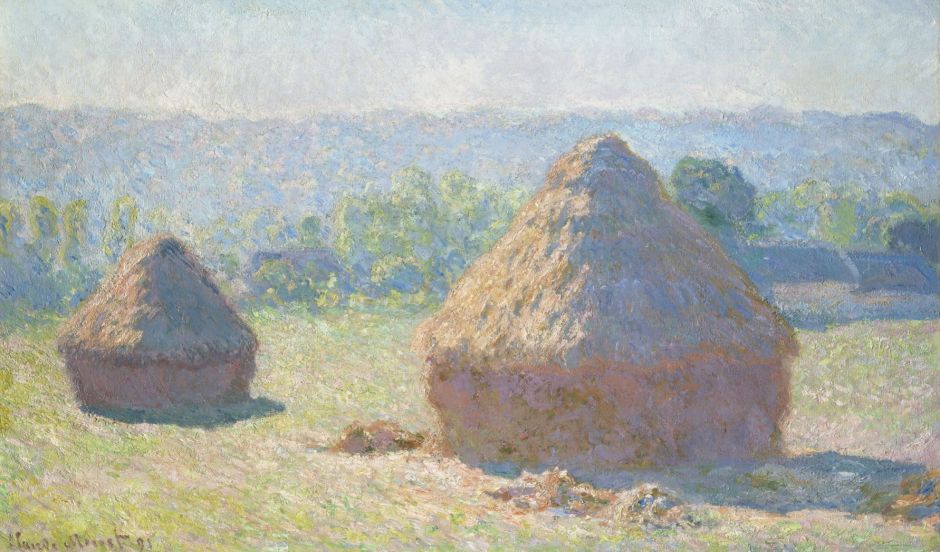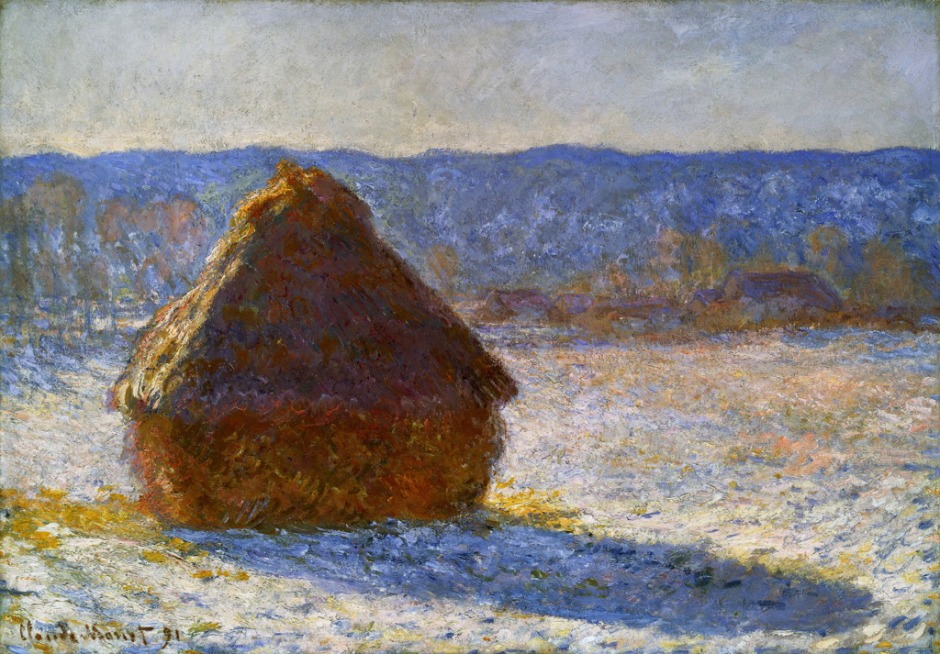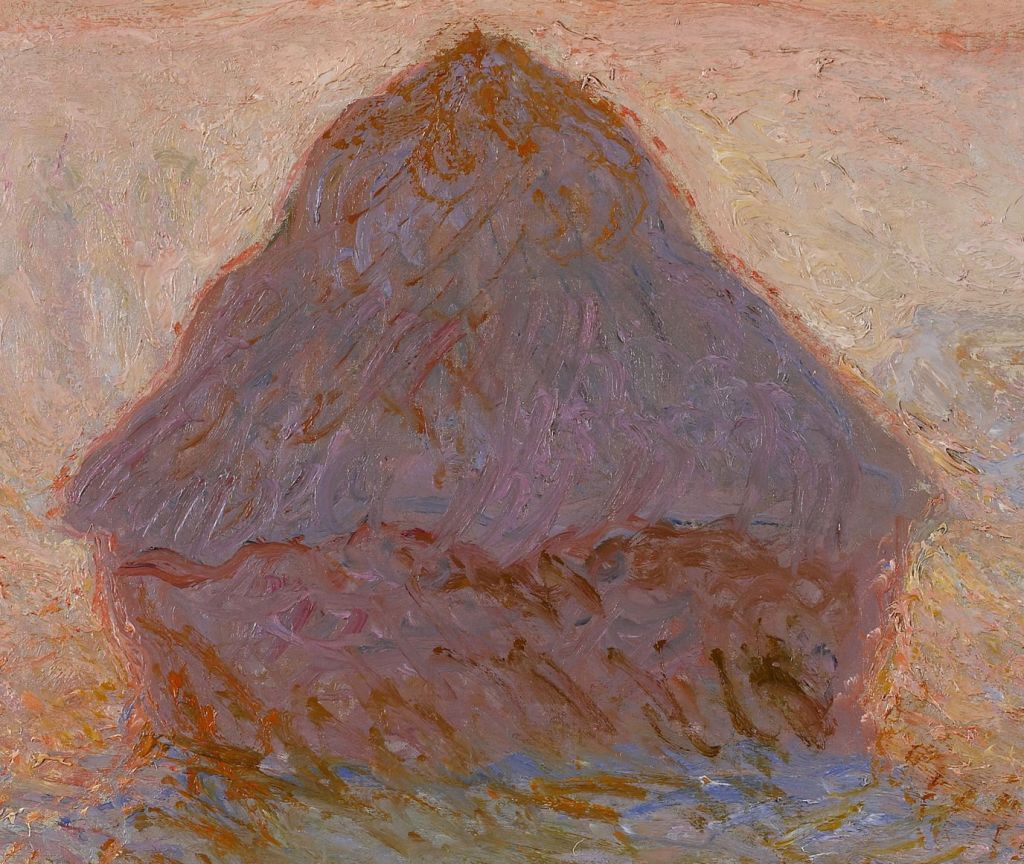Understanding how the French Impressionists created their masterpieces is one of the great problems in the history of painting. They were assiduously careful to reveal as little as necessary, and as a result their working methods have often been assumed to be simple: set up in front of the motif, paint briskly what the artist ‘senses’ in order to capture fleeting and momentary effects, resulting in an oil sketch completed over no more than a couple of hours, and that’s it, done.
The evidence from looking carefully at major Impressionist paintings is that, while that may have been true for some painters and certain of their paintings, many were created more deliberately over a longer period, much of which was in the studio and not in front of the motif at all. This article considers a series of some of the most Impressionist paintings of them all, Claude Monet’s Grainstacks, which he painted in a field next to his home at Giverny in 1890-91.
My evidence is drawn from the detailed and authoritative account of their creation in Daniel Wildenstein’s four-volume catalogue raisoné (Taschen and the Wildenstein Institute, 1996), and the paintings themselves. The narrative is in volume 1, pp 274-279, and the individual paintings are illustrated and detailed in volume 2 from p 482 onwards.
The French word in each of their titles is meules, which here means a stack of cut cereal with the grain still attached, a grainstack rather than haystack (which contains hay or straw, the threshed cereal). In the late nineteenth century in northern France, it was standard practice to cut cereal crops when they were ready at the end of the summer, then to stack the intact stalks and heads until an itinerant threshing machine visited the area, and the grain could be separated from the straw.
Claude Monet first painted a series of canvases depicting grainstacks at Giverny – literally outside his back yard – in 1889. In the early autumn of 1890, Monet started a fresh series consisting of two grainstacks, now accorded Wildenstein numbers of W1266 to W1279. During that winter, the farmer was able to start threshing, and one of the grainstacks was consumed.
Apparently Monet paid the farmer to retain the single remaining grainstack so that he could continue the series, allowing him to paint W1280 to W1290, each showing that single grainstack. After various delays during which Monet apparently made further adjustments to the paintings in the series, the first fifteen canvases were shown at an exhibition at the Durand-Ruel Gallery in Paris, which opened on 4 May 1891. They all sold, for sums of up to 1,000 francs, and provided Monet with an excellent return for the winter’s work.
The remaining ten paintings in the series were sold to Durand-Ruel and other dealers by the end of 1891, and all have now been dispersed into art galleries and private collections around the world. Wikipedia’s article on the series here gives further details. However the last time that most of the works in this series were shown together was in May 1891. The following year Monet started his still more famous series of Rouen Cathedral, which he completed in 1894.

By the 1890s, three Impressionists had painted substantial series: Monet, Pissarro, and Sisley. Looking through their work, this did not happen out of the blue, nor did two copy the idea from the third (as has been suggested). Prior to their first formal series, each had painted very similar views of the same motif on more than one occasion, and sometimes painted two or three almost identical views of the same motif.
However, these had changed from being short informal series, which might just have ‘happened’ that way, into formal exercises in which the painter deliberately returned to the same viewpoint and painted the same motif under a range of different weather conditions, at different times of day, and under different lighting conditions.
The myth about the Grainstacks is that they depict transient effects of season, weather, and light, as they were painted plein air over the course of the winter. Looking at all twenty-five, I have long had my doubts, and suspected that Monet spent a lot of the time prior to their exhibition making further changes to them, which could not therefore have been en plein air nor even faithful accounts of each motif at the moment they depict. This in no way lessens Monet’s sublime achievement, nor their art in any way. It’s just that they aren’t quite the paintings described by the myth which has grown around them.

Looking at Grainstacks, End of Summer, considered to be one of the earliest in the series and numbered 1266, the trees behind the two grainstacks are still in full summer leaf, with no indication of the advent of autumn. Yet Monet’s signature gives the year as 1891. Looking at its paint surface in detail (below), some has been applied wet-in-wet and blended with underlying and adjacent paint, but many other brushstrokes have clearly been applied over dry underlayers.

The blue-grey shadow of this grainstack was applied with relatively dilute paint wet-on-dry over thicker off-white paint which has marked surface texture. However, that off-white paint has itself been applied wet-on-dry over a pale green layer. This couldn’t have been achieved in the same day, even when the ambient temperature was warmer during the early autumn, but probably reflects at least three sessions with drying time in between them.
Looking later in the series, at paintings which were most probably started in early 1891, when there was still snow on the ground, there is strong evidence of similar methods, with layers applied wet-on-dry and pentimenti to adjust the composition. Drying of oil paint during the winter is prolonged, and it may have been weeks before underlayers were sufficiently dry for overpainting in this way.




Grainstack, Sun in the Mist, numbered 1286, is thought to be one of the later paintings in the series, apparently showing the sole remaining grainstack in the Spring of 1891. It too has multiple layers applied wet-on-dry, with many hatched brushstrokes in shades of orange and pink apparently applied over a well-dried surface. These are again shown well in the detail (below) of the grainstack itself.
At the right side of the foot of the grainstack, the lowest layer of paint consists of dull blue and green which appear to have been applied at about the same time and have blended in places. When that layer had dried, infrequent and relatively thick streaks of white were added wet-on-dry. When that had dried, brown-orange was applied to form the uppermost layer. That uppermost layer has also been used to remodel the form of the grainstack using thickly-applied flesh, pale yellow and orange paint.

The evidence points to Monet starting each of this series with a sketch using more dilute paint in front of the motif in the circumstances described in the title. He then brought each canvas into his studio, where he continued to work on it, making further adjustments, adding partial layers of paint, and tweaking each work in comparison to the others in the series. This would have taken place over a period of several weeks: in the case of the canvases which he started at the end of the summer of 1890, such as W1266 above, that period could have amounted to six months.
At this time, Monet painted almost entirely using tubed oil paint purchased from some of the hundreds of colourmen in Paris. He had a definite preference for more modern high-chroma pigments, and was an early adopter of cadmium yellows to reds, for example.
Even if these conjectures about Monet’s working methods are correct, they raise further questions about the role of memory and aesthetics during the continuing work on a painting, right up to one of the most difficult decisions of all, determining when to stop.

